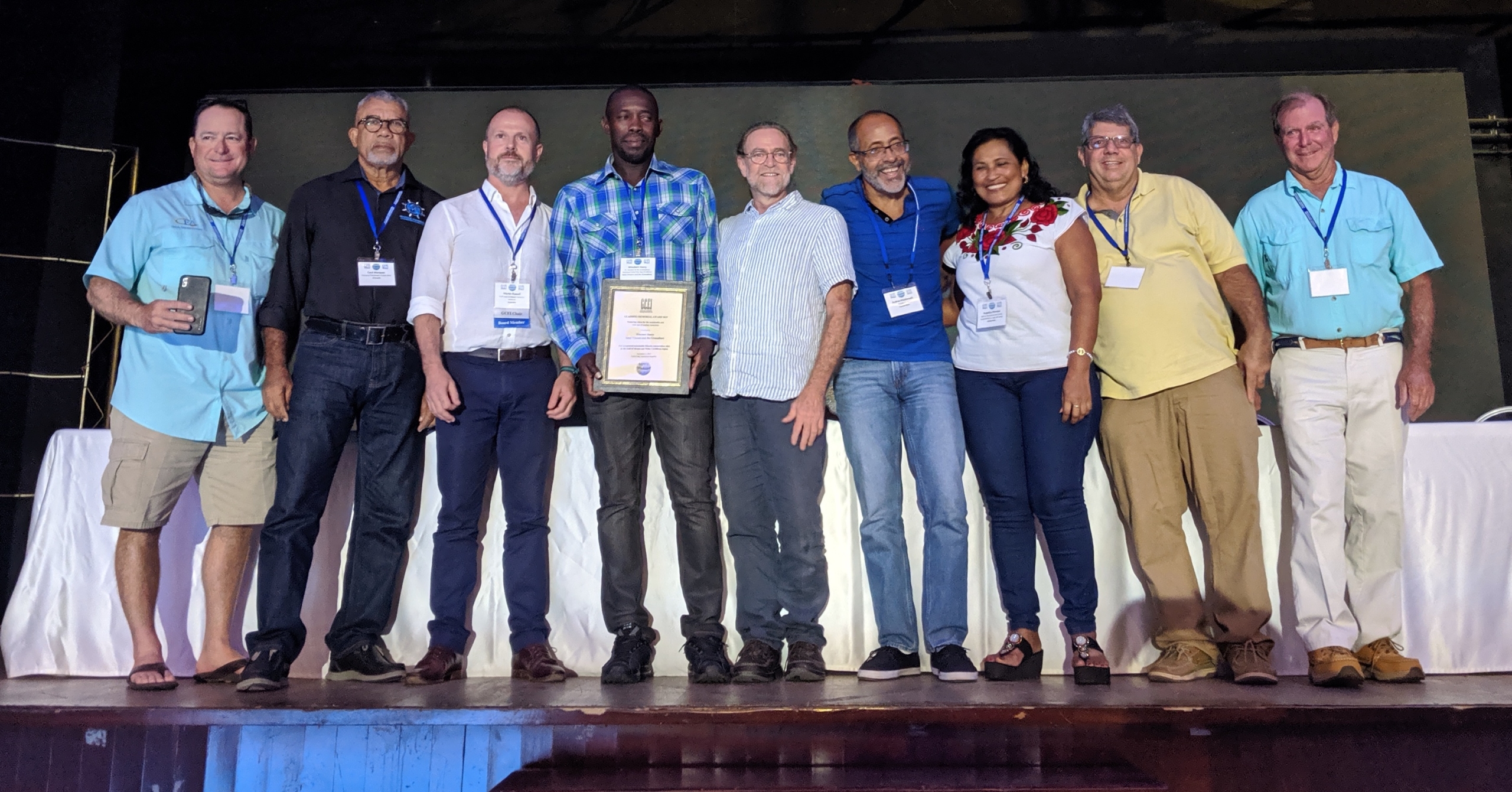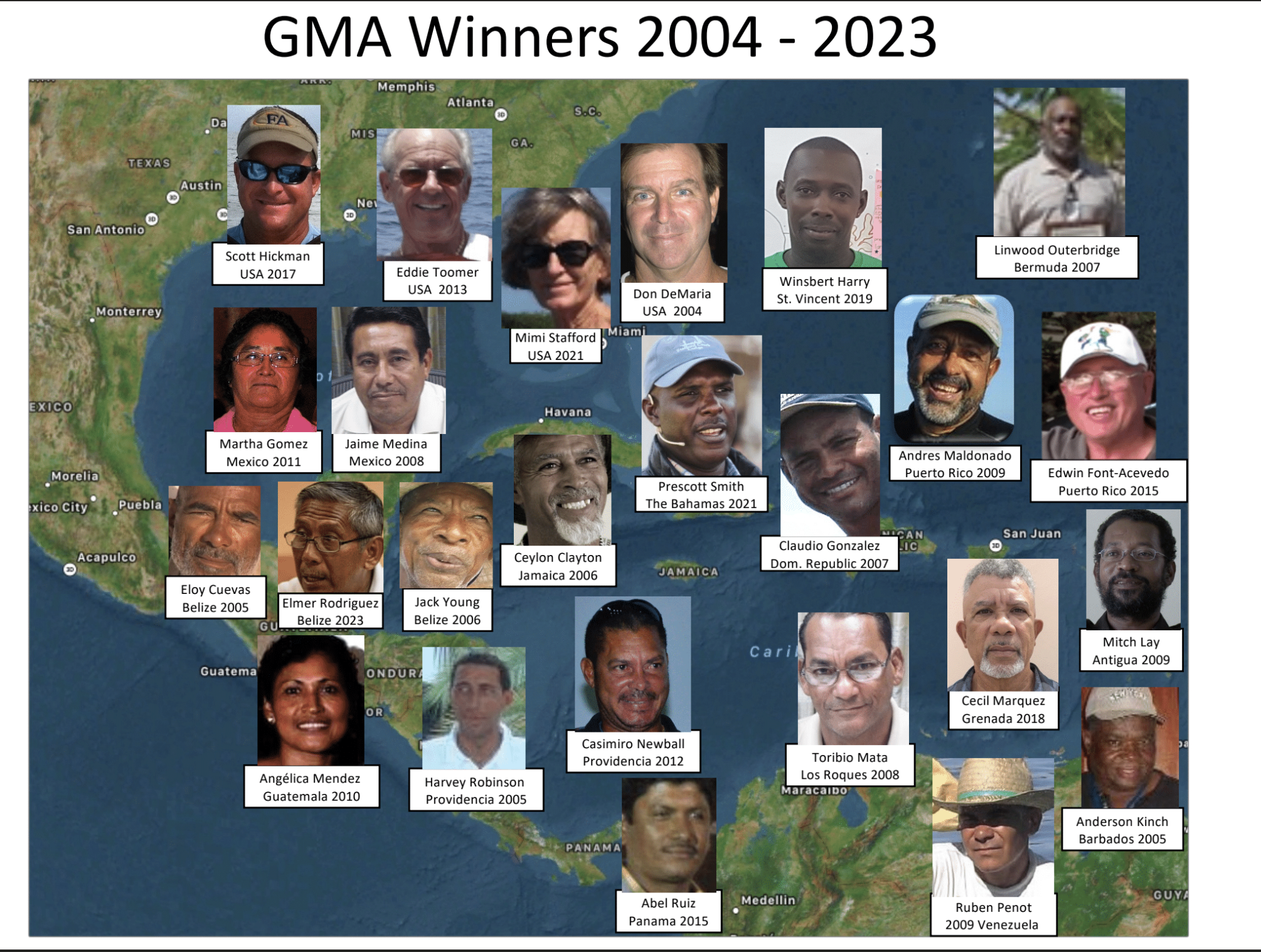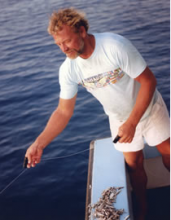The Gladding Memorial Award
Recognizing Fishers with an enduring Vision for the Sustainable and Wise Use of Marine Resources
To ensure that the insight of knowledgeable local fishers is always directly represented at the annual meetings of the Gulf and Caribbean Fisheries Institute, the Board of Directors approved the creation of the GMA in 2004. This award provides full travel funding for exceptional fishers to attend the annual GCFI conferences. Gladding was a model of the commercial fisher who became a profoundly influential conservationist. His vision of responsible fisheries management from the industry perspective helped lead to the establishment of the Tortugas Ecological Reserve.
Each annual recipient is selected by a GMA subcommittee composed of several GCFI trustees and one or more past recipients of the award. Fishers from around the Gulf of Mexico and the wider Caribbean Basin are eligible for the award. Each year the full board of the GCFI is solicited by the subcommittee to forward the names and rationale for likely candidates. Any GCFI member or fisher in the region is also welcome to suggest names, preferably through a board member with some familiarity with the fisher or the proposer. The GMA subcommittee subsequently evaluates the submissions and chooses the final award winners based on the fishing experience and the conservation actions of the candidates. Given the wide geographic, cultural, and language diversity of the region, every effort is made to ensure that winners represent the full geographic range of the region. To date, recipients come from Antigua and Barbuda, Barbados, Belize, Bermuda, Colombia, the Dominican Republic, Florida, Guatemala, Jamaica, Mexico, Puerto Rico, and Venezuela.
The more formal inclusion of fishers into fishery management conferences is overdue. The membership and board of GCFI are therefore pleased at the Gladding Memorial Award’s early success in fostering creative initiatives to put fishers shoulder-to-shoulder with scientists and managers. The award was initiated with grants and in-kind efforts from Environmental Defense and the Florida Keys National Marine Sanctuary; additional sources of funding have been provided by the United Nations Environment Programme – Caribbean Environment Programme and are encouraged to ensure the continued expansion of this initiative.
Learn more about our previous Gladding Memorial Award Winners through our Fisher Features
Map of GMA Winners
Previous GMA Winners
| Year | Name | Location |
|---|---|---|
| 2023 | Paulino Elmer Rodriquez | Belize |
| 2021 | Prescott Smith | The Bahamas |
| 2021 | Mimi Stafford | Key West, Florida |
| 2019 | Winsbert Harry | St Vincent and the Grenadines |
| 2018 | Cecil Marquez | Grenada |
| 2017 | Scott Hickman | Texas, USA |
| 2015 | Edwin Font-Acevedo | Puerto Rico |
| 2015 | Abel Ruiz | Panama |
| 2013 | Eddie Toomer | Florida, USA |
| 2012 | Casimiro Newball | Providencia, Colombia |
| 2011 | Martha Gongora Garcia | Q. Roo, Mexico |
| 2010 | Angelica Maria Mendez Parham | Livingston, Guatemala |
| 2009 | Mitchell Lay | Antigua |
| 2009 | Andres Maldonado | Puerto Rico |
| 2009 | Ruben Penott | Mochimo, Venezuela |
| 2008 | Toribio Mata | Los Roques, Venezuela |
| 2008 | Jaimie Medina | Punta Allen, Mexico |
| 2007 | Claudio Agustín González | Dominican Republic |
| 2007 | Linwood Outerbridge | Hamilton, Bermuda |
| 2006 | Ceylon Clayton | Little Bay, Jamaica |
| 2006 | Jack Young | Placencia, Belize |
| 2005 | Eloy Cuevas | Monkey River, Belize |
| 2005 | Anderson Kinch | Oistins, Barbados |
| 2005 | Harvey Robinson | Providencia, Colombia |
| 2004 | Don DeMaria | Florida, USA |
About Peter Gladding
Peter Gladding was what some in the Commercial fishing world referred to as “the ethical Commercial fisherman” and a “throwback to the days of wooden boats and iron men.”
Fishing was more than a means of making a living to Peter–it was a way of life that he deeply cherished. He had a connection to the resource that few fishermen today are capable of understanding. Although Peter did use some of the modern electronics, like a GPS and color fathometers / chart plotters, radios, etc., he relied more on his senses and years of experience to understand fish behavior and catch fish. Also, he caught everything the old fashioned way–either with a cast net or handlines. The old Key West Conch fishermen would often joke about Peter’s fishing abilities claiming “Peter did not follow the pelicans and seagulls around to fish the fish–the pelicans and seagulls followed Peter.” Although said in jest, many believed it to be true.
Peter’s life started out in Bristol, Rhode Island. The son of a marine salvage business owner, Peter was one of 7 children born to Bertha and Ray Gladding. One day in 1952, in true pioneer fashion, Ray loaded up the family and headed south to Florida–eventually settling in Key West. Instead of a covered wagon the family boarded Ray’s 65 foot salvage vessel the SalteSea to embark on a journey that would change not only their lives, but the lives of many others.
The first few years in Key West for Peter were spent going to school and working salvage jobs with his dad and brothers–often missing school. One day the truant officer came down to the docks and explained to Ray that if he wanted any of his kids to miss school, then he needed to fill out the appropriate paperwork. Ray calmly turned to his wife and said “Bertha, will you please go downtown with this man and fill out whatever paperwork he is talking about–these boys will learn more working with me than they will in any school.” And, so on that day, Peter Gladding started working on the water full time.
Eventually, young Peter was drawn into commercial fishing. Back in those days the ocean surrounding Key West was teaming with fish of all sorts. It seemed as hard as anyone tried, they could not make a dent in the fish populations. But, slowly over time, Peter began to notice changes. Along with more advanced electronics, larger netting operations, wire fish traps, and an increased demand for fish by health conscious Americans–fish stocks began to decline. Rather than increasing his efforts or shifting to more effective gear types–Peter continued to fish as he had always done — with handlines–catching one fish at a time– icing it down properly and always getting top dollar. However, he did speak out about what he perceived as unsustainable fishing practices and resource abuses.
Peter was a strong believer of spawning aggregation protections. His knowledge, and ability to convince the fishermen of the importance of protecting fish when and where they spawn eventually led to the creation of one of the most successful spawning aggregations reserves in the world — Riley’s Hump in the Dry Tortugas 60 miles west of Key West.
Negotiations between fishermen and NOAA on reserve boundaries for the Tortugas were at a standstill until Peter was appointed to the Tortugas 2000 working group. A combination of his vast knowledge of the Tortugas area (40 plus years) together with the respect of both the commercial and recreational fishing community made establishing boundaries and regulations relatively easy. Basically, Peter laid out the map, drew lines with his finger and said to everyone: “Look, this is where we should draw the boundaries.” Most fishermen agreed the boundaries looked like something they could live with and if Peter thought it was good–then so did they. Thus, the beginning of a world class marine reserve that not only protected the resource, but also took into account the needs of fishermen was created that day.
While many fishermen are secretive when it comes to fishing spots and methods, Peter was not. Often, he would help young fishermen get started–showing them where to fish and what type of gear to use. Peter believed that if you fished in a conscientious and sustainable manner– then there were plenty of fish out there for everyone. However, if you showed little to no respect for the resource, or other fishermen, then he would not even give you the time of day.
Peter’s dream was to travel throughout the Caribbean meeting and talking with other small-scale fishermen — discussing various conservation issues, such as spawning aggregation reserves and sustainable fishing practices. Unfortunately, Peter never fully realized his dream as his life was cut short with cancer due to his exposure to agent orange in Vietnam. The GMA process is a way of realizing the dream of Peter Gladding by recognizing those fishers who share Peter’s same vision of a well managed and sustainable fishery.
– Don DeMaria, 2023



